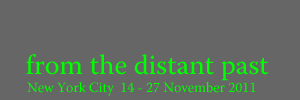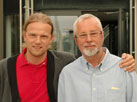

The bright green light waves pulsing over the facades of the Americain Museum of Natural History, the Maryland Science Center and the Palazzo Franchetti in Venice are a minimalist representation of the most distant objects in the universe discovered by the Hubble Space Telescope. These undulations projected by a green high power laser tell a story about the oldest colours in the universe originating from some of the earliest agglomerations of stars ever recorded.
So "From the Distance Past" reveals that Hubble and other astronomical telescopes do not only produce the familiar and spectacularly beautiful pictures of the sky. The astronomer's heart is often made to beat faster by the analysis that it is possible make of the most distant objects in the universe by the use of 'spectroscopy': the splitting of light into its constituent colours by a prism or a diffraction grating. The light emitted by stars, be they as close as our own Sun or as distant as the youth of the universe, caries the imprint of the chemical composition, the evolutionary state, and the mass of the shining star or stars. By its luminous animation, this faint colour echo of the primordial universe appears less as an abstract idea than as an anthropomorphic association with a heartbeat or a brain wave. This work makes a powerful connection between the long tradition of painting and with colour seen in a conceptually new way.
impressions from the projection on Maryland Science Center's wall facing the Inner Harbour
Never seen in public before, these observations represent the very limits of our knowledge of the distant Universe today. Due to the fact that these pixel constitute the end of resolution and that only the faint light consisting of a couple of photons may result in a spectral peak, "From the Distant Past" is not only a light trip back to the origins of the universe but also a walk at the borders of contemporary vision in general.
Art, colour & astrophysics
Art has always explored the phenomenon of colour. In the 20th century there were movements as colour field painting which exclusively focussed on the phenomenon on colour. Whereas colour in photography and printing is composed of only three basic colour dyes, colour in painting is often of a much higher complexity. Mixing on the palette and on the canvas pigments - each with a characteristic spectrum - the whole composition of hues might become almost as complex as the colour composition of celestial objects. So in a very conceptual way spectra as a formal description of colour bridge the two worlds of colours in art & astrophysics.
The artistic concept of "From A Distant Past" was developed by Tim Otto Roth in close cooperation with the astronomer Robert Fosbury, former head of the ESA's coordination office of the HST at ESO in Garching. They are currently publishing an essay discussing the chromatic revolution which spectra caused in astronomy and the resulting consequences for art and philosophy.
 Tim Otto Roth & Bob Fosbury at ESO Garching in 2009
Tim Otto Roth & Bob Fosbury at ESO Garching in 2009
Links
Bob Fosbury's webpage: www.eso.org/~rfosbury/
